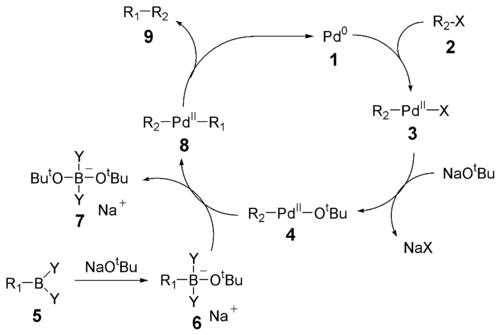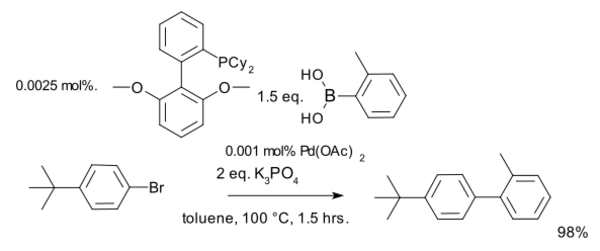تفاعل سوزوكي
تفاعل سوزوكي Suzuki reaction هو تفاعل عضوي لحمض أريل- أو ڤاينيل-البورونيك مع هاليد الأريل أو الڤاينيل محفوزاً بواسطة معقد الپالديوم(0).[1][2] ويستخدم على نطاق واسع لتخليق عديدات الاولفينات، والستايرينات، و ثنائيات الفنيل المستبدَلة، وقد تم مده ليضم بروميدات الألكيل [3]. Several reviews have been published.[4][5][6]
ويعمل التفاعل أيضاً مع الهاليدات الكاذبة، مثل triflates (OTf), بدلاً من الهاليدات، وأيضاً مع إسترات البورون بدلاً من الأحماض البورونية.
- تفاعلية نسبية: R2-I > R2-OTf > R2-Br >> R2-Cl
نشره لأول مرة عام 1979 أكيرا سوزوكي، the Suzuki reaction couples boronic acids (containing an organic part) to halides. The reaction relies on a پلاديوم catalyst such as tetrakis(triphenylphosphine)palladium(0) to effect part of the transformation. محفز البلاديوم (الذي هو في الواقع سابق-للتحفيز) هو رباعي الاحداثيات، وعادة ما يتضمن مجموعات داعمة للفوسفين.
In many publications this reaction also goes by the name Suzuki-Miyaura reaction. It is also often referred to as "Suzuki Coupling" (2010 Nobel prize).
آلية التفاعل
آلية تفاعل سوزوكي is best viewed from the perspective of the palladium catalyst. The first step is the oxidative addition of palladium to the halide 2 to form the organo-palladium species 3. Reaction with base gives intermediate 4, which via transmetalation[7] with the boron-ate complex 6 forms the organopalladium species 8. Reductive elimination of the desired product 9 restores the original palladium catalyst 1.
اضافة تأكسدية
Oxidative addition proceeds with retention of الكيمياء الفراغية with vinyl halides, while giving inversion of stereochemistry with allylic and benzylic halides.[8] The oxidative addition initially forms the cis-palladium complex, which rapidly isomerizes to the trans-complex.[9]
استبعاد اختزالي
انظر أيضاً
- تفاعل هك
- Hiyama coupling
- Kumada coupling
- اقتران نگيشي
- Petasis reaction
- Stille reaction
- Sonogashira coupling
الهامش
- ^ Miyaura, N. et al. Tetrahedron Lett. 1979, 3437.
- ^ Miyaura, N.; Suzuki, A. Chem. Commun. 1979, 866.
- ^ http://pubs.acs.org/cgi-bin/abstract.cgi/jacsat/2002/124/i46/abs/ja0283899.html
- ^ Suzuki, A. Pure Appl. Chem. 1991, 63, 419-422. (Review)
- ^ Miyaura, N.; Suzuki, A. Chem. Rev. 1995, 95, 2457-2483. (Review, doi:10.1021/cr00039a007)
- ^ Suzuki, A. J. Organometallic Chem. 1999, 576, 147–168. (Review)
- ^ Matos, K.; Soderquist, J. A. J. Org. Chem. 1998, 63, 461–470. (doi:10.1021/jo971681s)
- ^ Stille, J. K.; Lau, K. S. Y. Acc. Chem. Res. 1977, 10, 434–442. (doi:10.1021/ar50120a002)
- ^ Casado, A. L.; Espinet, P. Organometallics 1998, 17, 954–959.
وصلات خارجية
- Suzuki coupling
- Microwave Suzuki coupling: synthetic protocols from organic-reaction.com


